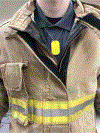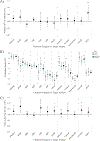Discovery of firefighter chemical exposures using military-style silicone dog tags
- PMID: 32521346
- PMCID: PMC9985454
- DOI: 10.1016/j.envint.2020.105818
Discovery of firefighter chemical exposures using military-style silicone dog tags
Abstract
Occupational chemical hazards in the fire service are hypothesized to play a role in increased cancer risk, and reliable sampling technologies are necessary for conducting firefighter chemical exposure assessments. This study presents the military-style dog tag as a new configuration of silicone passive sampling device to sample individual firefighters' exposures at one high and one low fire call volume department in the Kansas City, Missouri metropolitan area. The recruited firefighters (n = 56) wore separate dog tags to assess on- and off-duty exposures (ndogtags = 110), for a total of 30 24 h shifts. Using a 63 PAH method (GC-MS/MS), the tags detected 45 unique PAHs, of which 18 have not been previously reported as firefighting exposures. PAH concentrations were higher for on- compared to off-duty tags (0.25 < Cohen's d ≤ 0.80) and for the high compared to the low fire call volume department (0.25 ≤ d < 0.70). Using a 1530 analyte screening method (GC-MS), di-n-butyl phthalate, diisobutyl phthalate, guaiacol, and DEET were commonly detected analytes. The number of fire attacks a firefighter participated in was more strongly correlated with PAH concentrations than firefighter rank or years in the fire service. This suggested that quantitative data should be employed for firefighter exposure assessments, rather than surrogate measures. Because several detected analytes are listed as possible carcinogens, future firefighter exposure studies should consider evaluating complex mixtures to assess individual health risks.
Keywords: Firefighter; Occupational exposure; Passive sampling; Personal monitoring; Phthalates; Polycyclic aromatic hydrocarbons.
Copyright © 2020 The Authors. Published by Elsevier Ltd.. All rights reserved.
Conflict of interest statement
Declaration of Competing Interest Kim A. Anderson, an author of this research, discloses a financial interest in MyExposome, Inc., which is marketing products related to the research being reported. The terms of this arrangement have been reviewed and approved by OSU in accordance with its policy on research conflicts of interest. The authors have no other disclosures.
Figures







References
-
- Alexander BM. 2012. Contamination of Firefighter Personal Protective Gear:University of Cincinnati.
-
- Alexander BM, Baxter CS. 2014. Plasticizer Contamination of Firefighter Personal Protective Clothing: A Potential Factor in Increased Health Risks in Firefighters. J Occup Environ Hyg 11:D43–48. - PubMed
-
- Altenburger R, Backhaus T, Boedeker W, Faust M, Scholze M. 2013. Simplifying Complexity: Mixture Toxicity Assessment in the Last 20 Years. Environ Toxicol Chem 32:1685–1687. - PubMed
Publication types
MeSH terms
Substances
Grants and funding
LinkOut - more resources
Full Text Sources
Medical
Miscellaneous

